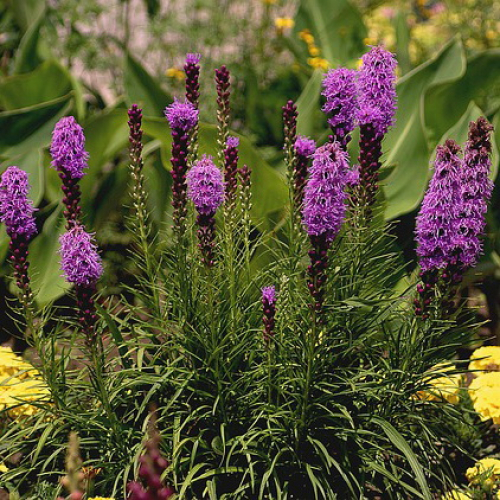Perennials Liatris

Description
Characteristic Features of Liatris
Liatris is genus of perennial plants of the family Compositae or Asteraceae. Liatris is native to North America. Wild species can also be found in the Bahamas, Central Asia, and Mexico.
The beautiful name of the plant derives from the combination of the Greek «laios» and «iatros» (smooth doctor). Indeed, in America, the shoots of the plant were used for medicinal purpose. Alternative names include Gayfeather and Blazing Star.
The plant height is 40 to 100 centimetres. The rhizome is tuberous. The stem can be erect, branched, or densely leafy. The leaves are dark green, narrow, linear, alternate, pointed at the ends, sometimes collected in the whorl. The flowers about 2 centimetres across are collected in spikes and may be white, pink, magenta, light blue, red, purple, or lilac. Flowers are borne in late summer; top flowers bloom before the bottom ones. The fruit is haired ribbed achene. The seeds germinate well.
In the garden, Liatris looks great in flower borders, rockeries, and mixed borders. The best companion plants are the baby's breath, brunnera, anaphalis, phlox, thrift, hosts, loosestrife, and stonecrops. Liatris is also often used for cutting and has a vase life of about two weeks. It is frequently used to create winter bouquets and arrangements together with field herbaceous plants. Recently, Liatris has been gaining popularity as a container plant.
The Liatris genus includes about 20 species, but only Dense Blazing Star (Liatris spicata) is cultivated as an ornamental plant. This plant reaches a height of two metres, has leafy stems, linear leaves, and tubular flowers that can be white ('Floristan Weib'), violet-lilac ('Kobold'), red-violet ('Pikador'), light blue ('Blue Bird'), lilac ('Silver Tips') or light violet ('Floristan Violett').
The Secrets to Successfully Growing Liatris
Liatris thrives in sunny areas with lightweight, dry, and fertile soil with neutral acidity. The plant does not tolerate waterlogging. Soggy soil can lead to root rot so water moderately. Ensure good drainage. In addition, the plant care includes loosening the soil, annual ridging, deadheading, and pruning of old shoots to give attractive shape. Some growers recommend cutting the entire aboveground part of the plant for the winter. Liatris responds well to fertilization during the growing season and does not require winter sheltering. However, it occasionally may freeze in snowless winters, so mulch the plant in late autumn with a 10 centimetres deep compost layer. Stake tall Liatris so that the flower stalks do not get broken in the wind. Every three years, rejuvenate the plant.
Liatris can be propagated by seed or vegetative by division.
Seeds are sown before winter or in the spring (in April-May) outdoors or in March indoors 1 centimetre deep. The plants only bloom on the second or third year.
Divide the shrub in the spring or autumn. Dig the plant out carefully, cut tubers into pieces, and plant spacing 15-30 centimetres apart and 10 centimetres deep.
Potential Problems
The weakness of Liatris is its root system. Corms are often damaged by mice, and the plant can sometimes be attacked by mole crickets and snails. Control pests by making insecticides in the soil. Snails can be removed manually.







 305
305







